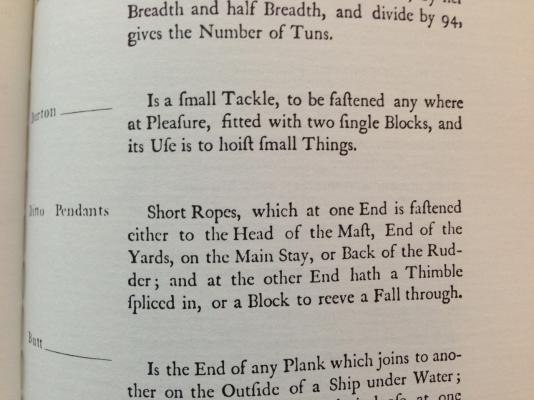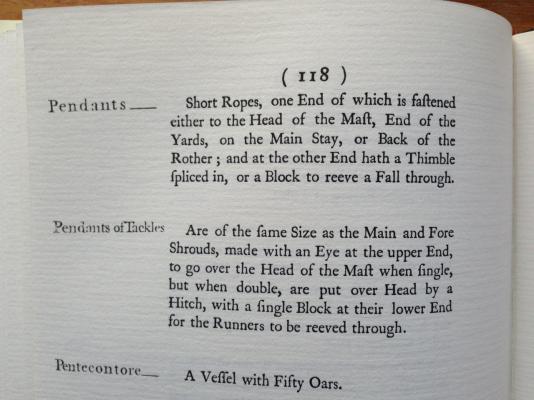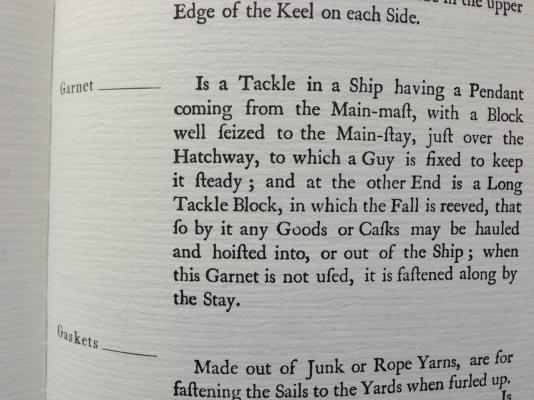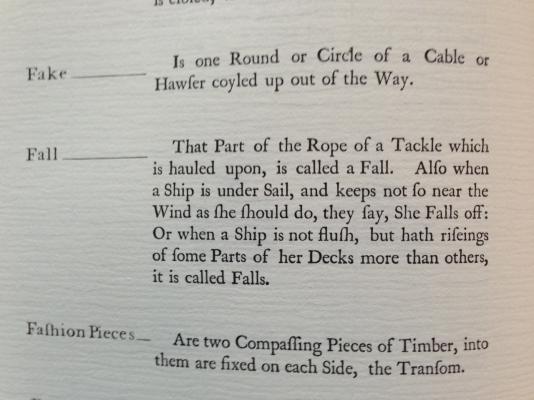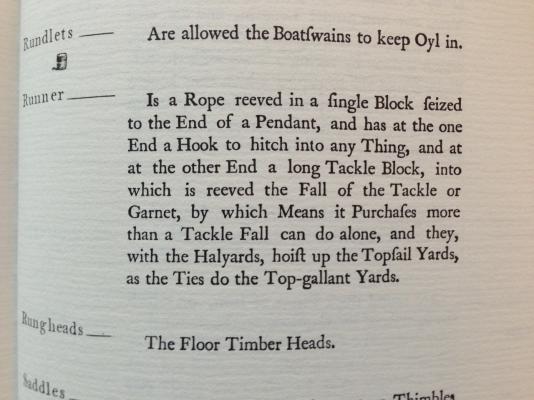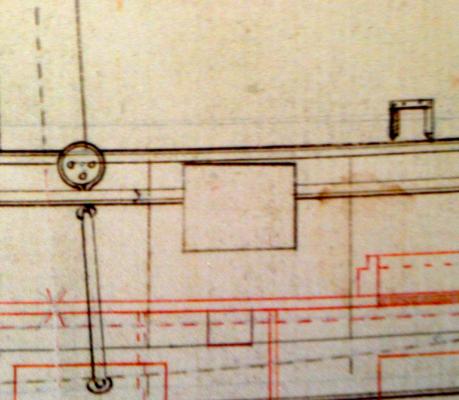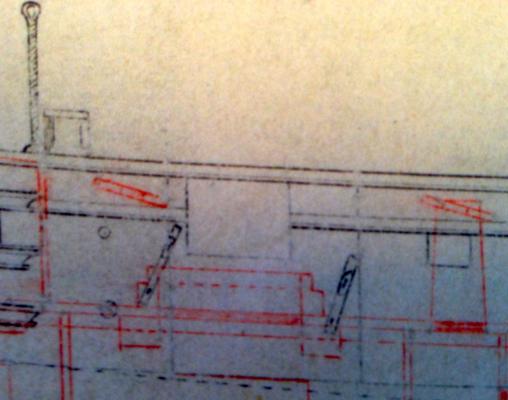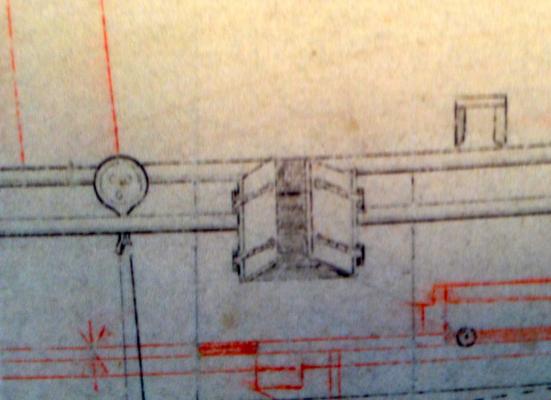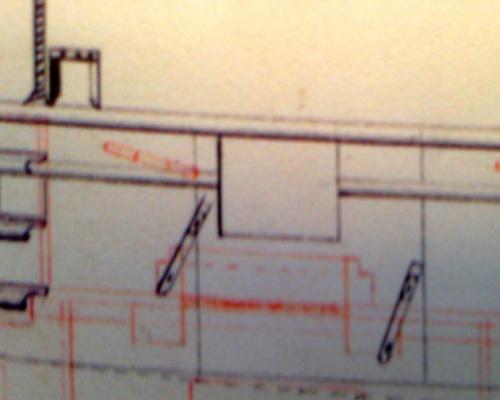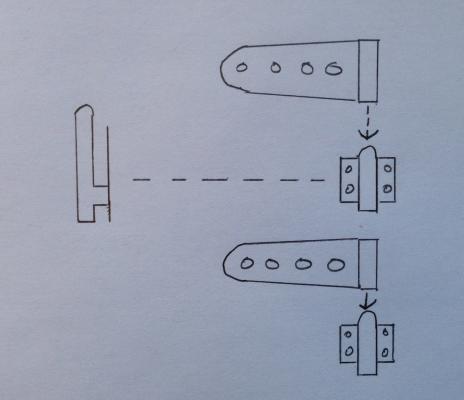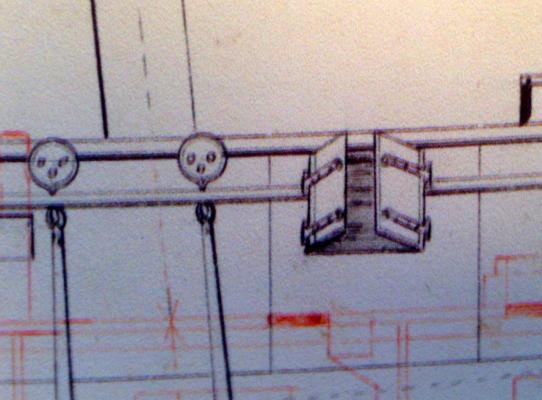-
Posts
589 -
Joined
-
Last visited
Content Type
Profiles
Forums
Gallery
Events
Everything posted by CAd My Fingers
-
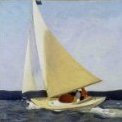
Burton Pendants, Tackle and Falls
CAd My Fingers replied to BANYAN's topic in Masting, rigging and sails
Pat, here's primary source info. (added a few cross-ref. definitions for addtl. details) from Blanckley's A Naval Expositor (1750): Falconer likely will move you closer to your time period and may also shed light as well; sorry, don't have a copy of his work on my shelves (yet!). Based on Blanckley, Lees, and Marquardt, your approach is sounds appropriate for the period you're rigging. Cheers, Jay -
Very well done--looking forward to see her rigged! Thanks for sharing, Peter! Cheers, Jay
- 28 replies
-
- cutter
- lady nelson
-
(and 3 more)
Tagged with:
-
Thank you Gregor! Too bad it only works with brass...it still does a nice job. I will see if I can obtain this in the States--didn't look closely at the label but as you pointed out, the formula is there, which I now see! Thanks! Jay
- 210 replies
-
- Sherbourne
- Cutter
-
(and 5 more)
Tagged with:
-
Wow, Gregor those look really nice! Would love to find a similar blackening agent here in the US! Thanks for sharing! Cheers, Jay
- 210 replies
-
- Sherbourne
- Cutter
-
(and 5 more)
Tagged with:
-
Don, I'm using CorelCAD and ran into similar issues with my body plan station curves. I lifted a lot more points and used splines for the stations and that seemed to work (still have do proof diagonals). So I think your approach is a good solution--will be curious to read how your scaling up works out for you. Cheers, Jay
-
Very nice, Gregor--I really like the lettering and your pin rails look great! The blackening from the chemist looks like it worked really well...have always had mixed results with Krick and other brands. Cheers, Jay
- 210 replies
-
- Sherbourne
- Cutter
-
(and 5 more)
Tagged with:
-
Russ, it's been a pleasure catching up on your latest work--all very nicely done! Wow, the size of those chain plates you made--1/32" makes my eyes hurt (thank goodness for our magnification visors--I often think that's the best tool I have in my box!)--and really liked how you made the pins for them--well done! Glad you're getting some time in the shop, and I'll look forward to your 1/24 build when you start her: fully framed will be a beauty to see! Cheers, Jay
-

Gun port lids and sweeps, on small vessels
CAd My Fingers replied to Stockholm tar's topic in Wood ship model kits
Right, Tony on the lids. There's just no "meat" between the upper port edges and the rail. I haven't yet worked out the scantlings for the rail widths, but am pretty sure they will overhang the ship both in- and outboard, which would likely make it even more difficult for mounting hinges. Additionally, the rail either has a lip or an indention that is a 1/2" (~1.3 cm) above the lower rail edge (that feature probably is not distinct in the plan photos I attached--but if you see a faint line just above the lower rail edges, it runs the entire length of the rails and it is what I'm referring to) and this feature likely might further complicate mounting hinges. Spot on Kester--ya leave for a spell and the thread goes wild! Kidding aside, I'm with you about this being great discussion! At this point, the only thing we can state that's beyond doubt is that lids are shown on the 2 as-build draughts. Everything from there on is just conjecture unless information on these details show up, like you say, in primary source documents. I'm planning on obtaining some primary source material as I move further into the project, and hopefully it will shine some light on a number of details. Perhaps by this coming spring, I can shift gears a little and spend more time on research after I am closer to finishing my initial draughts. At the rate I'm going though, those draughts may take years...there's been lots of do-overs...lol! Cheers, Jay -

Gun port lids and sweeps, on small vessels
CAd My Fingers replied to Stockholm tar's topic in Wood ship model kits
Adding to what Druxey said about unshipping the half lids, the arrangement I theorized about could also unship in heavy seas and thus defeat the purpose of using port lids in the first place! Gotta be objective and look neutrally at all the possibilities...I guess it's a good habit gained from my work (but taking two sides to an issue can be irritating to some). In the meantime I'm going to just keep pluggin' away at getting some plans drafted...that's enough challenge and then some for now! Tony, this isn't a definitive answer to your 1st question but I think there would be enough room with the cannons ran in. Lavery gives a length of 4'-6" (~1.4m) for a post 1743 7cwt 3 pounder (Arming, 103). Eventually I'll drill down into researching cannon and carriage lengths in-depth, but using Lavery's numbers as a quick guide, it looks like there'd be room everywhere except in the bow (won't comment much on whether or not cannon were even regularly placed in the bow--looks pretty tight once the bowsprit is factored in, plus I'm guessing it'd be a serious chore hoisting a darn gun into position up there...I think a 7cwt cannon weighs in at close to 785 lbs / 356 kg). Cheers, Jay -

Gun port lids and sweeps, on small vessels
CAd My Fingers replied to Stockholm tar's topic in Wood ship model kits
This is an excellent discussion; thanks everyone for weighing in and adding to the dialogue—this ability to share and discuss ideas within our community is one of the many outstanding aspects that makes MSW so great! I mentioned yesterday that I didn’t see port lids on the several other circa 1763 cutter draughts I’ve looked at. If I were building one of those ships, I would definitely leave port lids off those builds unless I found proof that they where used by that ship in that ship’s primary source documentation (for instance, its logs). From just the draughts though, there just is no evidence that those ships had or used port lids. In the case of the Sherbourne, the lids definitely are in both of her as-built draughts as opposed to her as-designed draught. CHN 0224: As Built CHN 0102: As Built ZAZ 6381: As Designed So for the Sherbourne, I believe a builder is on very solid ground if they choose to include them in their build. To take the ports lids a step further, yesterday I theorized that the side-hinged port lids may have been removable using a hinge system similar to a rudder gudgeon-and-pintle arrangement. Rough Drawing: Here are some facts along with some of my assumptions behind that theory: We can see where half of a lid will be over backstays at the aft port in both as-built draughts: perhaps not a great thing with permanently mounted lids; also, the lids wouldn't fully swinging open. Aft port of both as-built draughts: One of the highest deck-to-sheer-rail-top locations is the forward port at about 3'-3" (~1m), while the distance from the sheer rail to a port-lid lower edge is about 2' (~61cm): a lower port-lid edge would be within about an arm’s reach of a sailor bending over the sheer rail. From quick measurements, I get 9-1/2” w x 11” h x 1” thick (~24cm x ~28cm x ~2.5cm) dimensions for a half lid: the lids wouldn’t be too heavy to lift (a down-and-dirty weight for a square foot (~0.3 sq m) of oak is ~4lbs. - ~1.8kg). The channel is inset by about 6” (~15cm) from the 2nd port opening and about 9” (~23cm) from the 3rd port opening and thus would interfere with fully swinging open both those port half lids: potentially two more reasons for removable lids. With the exceptions of heavy seas, overall I can see how permanent mounted side-hinged lids could be generally a pain in the rear. The theory I just presented also can be a basis for not attaching lids: Pintles at the ports would make for some nice details, too. However, all of this extra about removable port lids is just a theory based on a combination of facts and my assumptions that is fun stuff to share and consider about the ship. I wouldn't pass this off as anything other than as a theory that’s wholly open to debate and to differing opinions unless I came across information in Sherbourne primary source documentation, like ship logs or etc., that either conclusively proved or disproved that the lids were removable. Plus, how many folks will even notice this type of detail in a 1:64 or a 1:48 build? The draughts on their own simply don’t offer enough information on this to say one-way or the other that her port lids were removable or that port lids were even used throughout her entire career! At this point, all I can definitely state about port lids are that they are depicted on both her as-built draughts. Cheers, Jay -
Mark, one of my personal sayings is "it's not about what knocked us down; it's about how we get back up." You fully epitomize that with your decision to start anew and use lessons learned to build an even better Licorne! And ya know what, this new one's gonna be an even more kick-butt beautiful build not only because of the skills you'll be bringing to it, but also because of the heart you'll put into her! Semper Fi, buddy! Jay
-

Gun port lids and sweeps, on small vessels
CAd My Fingers replied to Stockholm tar's topic in Wood ship model kits
Have been down sick for a spell; now that I'm starting to feel human again, it's been fun catching up on all the great club Sherbourne posts that everyone has made recently--great work and excellent reading! I've enjoyed reading through the discussion here, and figured I'd throw in my 2 cents worth. First I’ll chime in on the sweep ports and gun port lids. Druxey is 100% accurate in what he stated about the Sherbourne. I’m working off all 3 draughts that he cited: two draughts are her as-built and the 3rd is of her as-designed. In all plans, 4 sweep ports are present. In both her as-built draughts, a port lid is present on the 4th port (going from aft forward). Of the several other draughts of the Sherbourne’s period that I have looked at, none showed port lids. Why is only one port lid depicted in the Sherbourne’s plans? I conjecture that only one port lid was drawn in for the same reason that a half breadth plan is only a half view or that a body plan is on one side an aft body view and on the other side a fore body view of the ship: why be redundant? In other words, including lids on all the plan ports would have been redundant where depicting just one port lid suffices to convey meaningful, relevant information. After diving pretty deeply into how draughts were created and etc. these past several months, I conjecture that the port lid was not a fanciful addition by the individual(s) that drafted the Sherbourne’s 2 as-built draughts. From Deane through Steel, the art of creating a draught is anything but fanciful: The methods laid out are fairly strict and somewhat rigid, which makes sense given that Royal Navy ships had to be built to reasonably survive both the sea and its weather as well as combat. Sticking in port lids out of fancy doesn’t seem consistent with the discipline. Likewise, seeing fanciful inclusions in two separate as-built draughts doesn’t seem consistent. Lastly as an overall organization, the Royal Navy during that period was one that was pragmatic and frugal…fanciful license in draughts doesn’t seem consistent with that culture. To the contrary, the port lids may be a bonus detail of the ship that may have been omitted from her contemporaries’ as-built plans. In fact, the Sherbourne is a remarkably well-documented ship in comparison to her contemporaries or at least more of her plans are extant than others. When I first looked at the port lids some months back, their side-opening feature didn’t seem practical. As I’ve worked on her over these past several months, I’ve come around on that opinion. I’ve been curious about if the port hinges allowed for removing the ports—very easily done with side-hinge port lids. Once I begin getting further into her details, perhaps more information about her port lids will surface. With that said, at this point I am more inclined to include them in a build than I am to omit them. Next I’m going to talk at length about the AOS Alert. While I've obliquely mentioned it here and there in the past, I'm going to be explicit here about Goodwin and AOS Alert. To be quite blunt, I strongly believe that large swaths of Goodwin's material should be viewed with healthy skepticism and here's why. Let me first begin by providing some of my background. By profession I am a researcher. Essentially all that I do is evidence based upon source documentation, verifiable numbers, and etc. In my written work, all is supported by underlying, verifiable documentation. When inferences are drawn from a wealth of evidence, a statement to that effect is made. Before any of my written work goes public, it is peer reviewed. All statements and assertions I make are reviewed by independent reviewers to ensure everything is fully supported with verifiable evidence. Our process is very similar to academia in particular: Peer review of scholarly published writing is a cornerstone of that material and thus its veracity. So when I use the term skepticism it here does not imply looking at things as falsehoods, it simply means being as objective as possible--neutral--and drawing conclusions based on verifiable evidence and or on reproducible results (by this latter, I mean that if you are told 2 + 2 = 4, you can use those facts and reproduce the same results). I next want to mention the fallacy of authority. This logic error results when someone in a position of authority makes an alleged fact-based statement and we in-turn believe that statement to be true on the basis of the person’s position rather than the material they are giving and the authenticity of its underlying facts. We can encounter this fallacy with published material: It has been published, therefore it must be true. Similarly if a person is an expert in their field, what they tell us about their field of expertise must be true. In both cases, it ain’t necessarily so, and this is where skepticism comes into play: Rather than look at the book or the individual, one must weigh the material that is presented. Is it supported with verifiable evidence?, do conclusions reasonably follow from evidence?, and so forth. Goodwin presents a lot of interesting material in AOS Alert. However, note that much of his textual material is not directly cited. Yes, Goodwin provides a bibliography, but that is far different than providing in-text citations! At one time, it was acceptable practice to include a source in one’s bibliography if the book was consulted though material from it was not directly used to materially support one’s written work (when used excessively, it's called "bib. padding"). Here's an excellent example of what I mean about the lack of citations: Goodwin asserts, “Prior to the turn of the eighteenth century all cutters were clinker-built.” Skepticism dictates that we neither believe that claim is true nor is false. However, skepticism further propels us to ask the question, “Upon what evidence?” “All” is a powerful assertion and this evidence Goodwin does not provide: Upon what factual supporting documentation is he supporting this claim with? Where and what is the evidence that we can also go to, read, and say, "Yep, that's true! Every single bloomin' cutter ever built prior to the 18th century was clinker planked." On the other hand, if we were to find just one instance of a cutter being carvel planked prior to the turn of the 18th century, then his entire assertion is false (“all cutters”). Note that in the scantlings Goodwin provides for Alert he does not cite a source. Did he obtain his scantlings from the Rattlesnake’s draught, or are they from The Shipbuilder’s Repository (SBR), which he cites on page 12 but fails to list in his bibliography, or a combination of both? Where does this scantling information come from? I spot checked some of Goodwin’s scantlings against the SBR and this perhaps is partially his source. For example, the SBR lists for a cutter a 2’-2” room and space, 18 as the number of rooms in the after body, and 13 as the number of rooms in the fore body (SBR, 258). Those numbers are identical to the ones given by Goodwin in his room and space section (Alert, 24). On the other hand, the room and space for the Rattlesnake (Alert, 46-47) and the Sprightly (Alert, 48-49) measure at 2’-0” using their respective scales—perhaps reproduction errors?… It's also worth noting that those SBR numbers are for a keel length (i.e. by the keel for tonnage) of 58'-6" (SBR, 234) whereas for the Alert that measurement is 52' (Alert, 23)…we're looking at a 6'-6" difference but the same room and space! The question remains: From where did Goodwin source his information? After his room and space scantlings, Goodwin provides frame bolt scantlings. The verbiage Goodwin uses here (Alert, 24) is clearly and obviously directly lifted from the SBR (SBR, 258-260): Although plagiarism was a relatively acceptable practice in 18th century, it certainly was not in the 20th or in the 21st!! But back to frame bolts: Although the number of bolts is the same—2—between Goodwin and the SBR, the bolt diameters are not. Goodwin states a 1/2" diameter while the SBR states a 3/4" diameter. What’s the big deal there? Where did Goodwin get 1/2" from—what is his source? In both the SBR (260-261) and in Steel (Naval, Folio V), the smallest bolt diameter given is 3/4." Indeed, Steel cites a 3/4" diameter bolt for his smallest ship listed: a 60 ton sloop (Naval, Folio V). I’d like to point out that in his The Construction and Fitting of the Sailing Man of War 1650 – 1850, Goodwin provides on page 14 a visual description of room and space that is inconsistent with that given in most other sources (for instance see Steel’s Naval Architecture pages 57 and 191). While I have may missed it during this quick re-skim of Alert, I do not believe Goodwin gives a burthen in tons for the Alert. The as-built burthen given for the Rattlesnake is 184 54/94 tons (Alert, 47) and the Sprightly’s is listed as 150 6/94 tons (Alert, 49). Compare those numbers to the 273 ton cutter in the SBR (which incidentally is listed as a vessel with 16 carriage guns and 22 swivel guns (SBR, 226)). Now think of scantlings between those sizes of ship and ask the question, “Are we looking at apples to apples or at apples to oranges if Goodwin selectively used SBR scantlings for the Alert? Am I saying that all of AOS Alert is wrong? No! I am saying that too much of the book’s material in not adequately supported to sources and there are too many unexplained inconsistencies. Furthermore when I see obviously plagiarized material, I am immediately extremely doubtful about an author and about the validity of their scholarly material with which I am being presented. To be very blunt, Goodwin’s AOS Alert would not pass a peer review as it is written (its un-cited, plagiarized material alone is an immediate fail). Compare AOS Alert work to May’s The Boats of Men-of-War (which Goodwin cites in his bib.): May provides nearly 200 citations to his sources in his 122 (as shown in my copy) page book. While Goodwin’s AOS Alert has its merits, I would be very hesitant to use his material to base essential areas of a build on or from which to make claims upon without additional, independent verification. Cheers, Jay -

Essex - Process and corrections to the new Model Expo Kit
CAd My Fingers replied to samueljr's topic in Wood ship model kits
Sounds great, Sam! Know you're doin' kick butt job on the fine tuning and wish you smooth sailing on the finishing touches of that project! Cheers, Jay -
Very nice work, Christian! If you have the time, I would love to see your steps in building a frame! I'm especially interested in your cant frames when you reach that stage...those always look like they are very difficult. Again, beautiful work--definitely looking forward to following your build! Cheers, Jay
-
Gregor, I love what you came up with for the gun port lids--they look great, and the cleats are a very nice touch! Also, your jeer bits and pawls are excellent--I will remember your plier technique for making the gears. I agree with you that the handles might be short and it's likely that the crew extended them for extra leverage--makes sense. Also, will file away what everyone is mentioning on the belaying points--I have figured that this will be a tricky part of building the ship. I know the kit's instructions offer no insight into where many of the halyards running ends lead to and are not very helpful in this regard. Although I have Roger Cole's Alert work, I haven't yet gotten too far into it--I know he disagreed with Goodwin on several points. From the initial research I've done, some of Goodwin's research is a bit sketchy... Will perhaps go into that more once I start building, but for now, I'm staying silent until I have more material to support my work. Thanks again for sharing with us your latest work--it's great! Cheers, Jay
- 210 replies
-
- Sherbourne
- Cutter
-
(and 5 more)
Tagged with:
-
Tony, Happy Belated-Birthday! Like Gregor said, a simple like isn't enough for your latest upgrades! You regularly come up with great innovations to improve your build and accompany them with excellent tutorials--your most recent is no exception! Had a good laugh about the vacuum...that's happened to me on a few occasions. I will remember your and Dafi's grating work...if I ever can get to that construction point (sigh! ). Likewise, I'm with you on tools upgrades. On the one hand, it's nice to keep things simple but on the other hand, they can lend a precision that's not always quite possible with doing things by hand--to wit, your shot racks. I ran into the same with a build, the extra tools helped tremendously with improving the appearance and simplifying the tasks I was working on (plus, they help lessen some frustrations!). Like you, I'm looking forward to seeing Dirk's rigging! Between Kester and his work, we'll have some excellent references to follow when we get there! Thanks again for your wonderful ideas that you freely share and also, again, Happy Birthday! Best wishes, Jay
- 269 replies
-
- Caldercraft
- First build
-
(and 3 more)
Tagged with:
-
Hi Jan, Congratulations with your planking--it looks good! Tony is right about us being our worst critics--would we tell our loved ones sometimes what we tell ourselves? In my view, I believe the most important thing about first and second builds is what we learn vs. how well the ship looks. You are learning many valuable things both about building boats and probably about your self and it sounds like you are loving those discoveries! It is that learning that makes these first projects perfect and beautiful! I'm looking forward to following your progress! Cheers, Jay
-
She looking very nice--those rods look great! Don't blames you for scrapping the sails...they're a pain in the butt, esp. if they're poor fit. Also, no indication in the kit of where they belay to or etc. Next kit? Are you in the UK or US Dan? If UK, then MS kits may be expensive in terms of shipping costs and customs. For your next build by all means get a kit that you like and will also challenge you/build upon your skill sets. Personally, I think smaller builds are great because they're relatively quick. Also one will build up a lot of skills fairly soon--doing a second smaller build will reinforce and build upon much of what you've learned already. Also they're not too expensive--if they get screwed up, you're not out on a lot of money or too much time. Definitely, doing a build you like is key! Cheers, Jay
-
Alistair's right about the brass rods vs pedestals--wish I had thought of that with mine. Maybe surf the Longboat logs here on MSW for some ideas--several builds did an exceptional job with rods. Yep, the crappy quality of the sails were frustrating to say the least on my build...sounds like yours are the same or worse, good call to leave them off! Cheers, Jay
-
Your rudder looks great, Dan--nice work! Dan, a "gotcha" I ran into with my kit are the sails and mast/bowsprit lengths. If you intend to install your kit's sails, be sure to check the lengths of your mast and bowsprit against the actual lengths of your kit sails before you cut any wood! Also layout the entire rig for the mast--i.e, position your gaff, mast bands, and etc. before cutting the mast. If you only use the mast/bowsprit lengths from the plans, you may wind up with a mast and or bowsprit that's not the correct length. A hard lesson learned here! Happy New Year to you and yours! Jay
-
Tim, she's lookin' sweeter all the time--a real beauty! Lousy weather has it's benefits...build time! Cheers, Jay
About us
Modelshipworld - Advancing Ship Modeling through Research
SSL Secured
Your security is important for us so this Website is SSL-Secured
NRG Mailing Address
Nautical Research Guild
237 South Lincoln Street
Westmont IL, 60559-1917
Model Ship World ® and the MSW logo are Registered Trademarks, and belong to the Nautical Research Guild (United States Patent and Trademark Office: No. 6,929,264 & No. 6,929,274, registered Dec. 20, 2022)
Helpful Links
About the NRG
If you enjoy building ship models that are historically accurate as well as beautiful, then The Nautical Research Guild (NRG) is just right for you.
The Guild is a non-profit educational organization whose mission is to “Advance Ship Modeling Through Research”. We provide support to our members in their efforts to raise the quality of their model ships.
The Nautical Research Guild has published our world-renowned quarterly magazine, The Nautical Research Journal, since 1955. The pages of the Journal are full of articles by accomplished ship modelers who show you how they create those exquisite details on their models, and by maritime historians who show you the correct details to build. The Journal is available in both print and digital editions. Go to the NRG web site (www.thenrg.org) to download a complimentary digital copy of the Journal. The NRG also publishes plan sets, books and compilations of back issues of the Journal and the former Ships in Scale and Model Ship Builder magazines.


